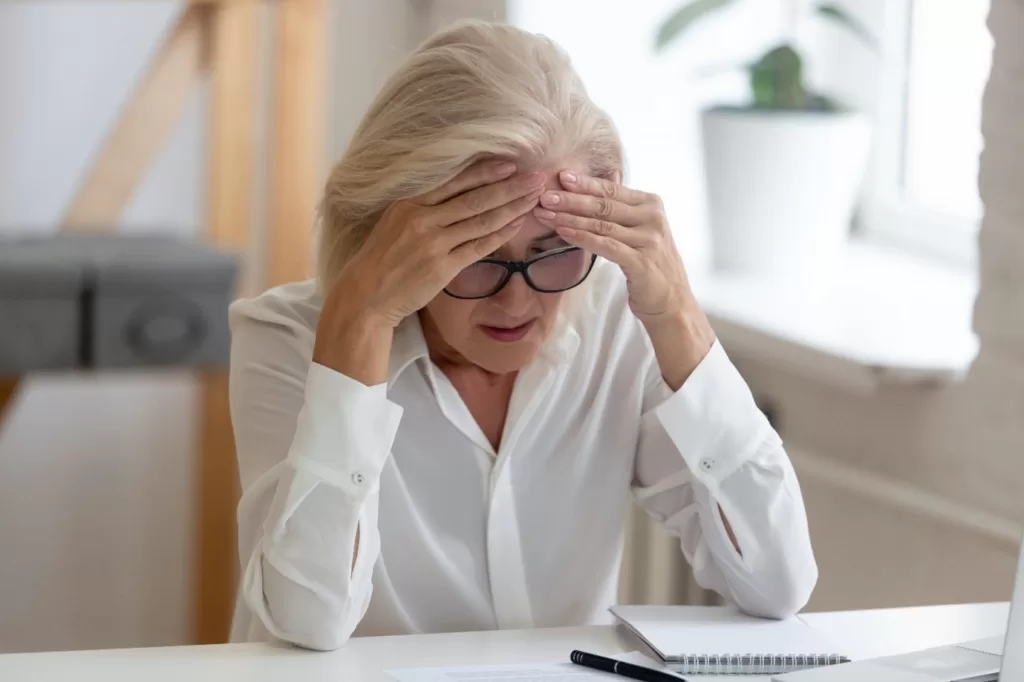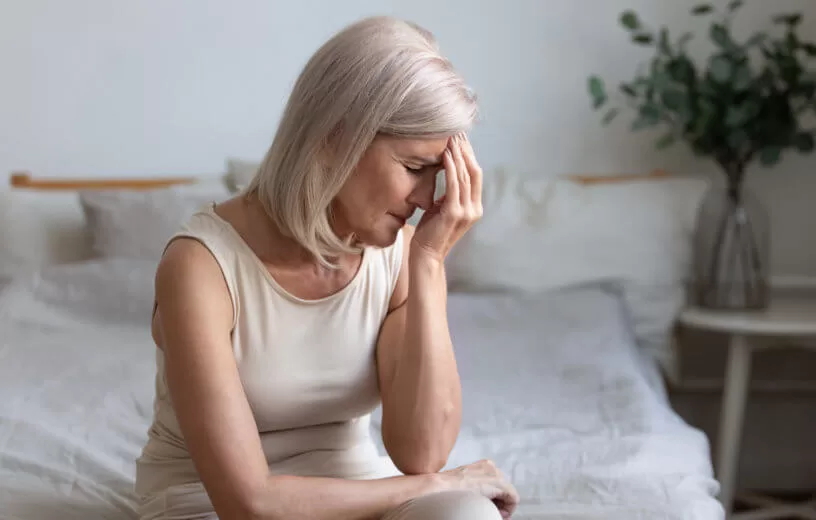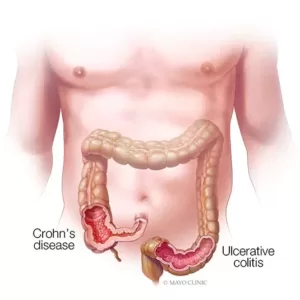Having your period end is likely to be a relief, but that doesn’t mean you should rush toward menopause. The menopausal transition often begins in one’s late forties or early fifties and lasts for a few years. Currently, menopausal symptoms are experienced by at least two-thirds of women who have reached menopause. Menopause can cause a number of symptoms, such as hot flashes, night sweats, mood swings, irritability, and tiredness.
After menopause, women are more likely to have health problems like obesity, diabetes, osteoporosis, and heart disease. Once a woman hasn’t had her period for a year, she has moved on to a new stage of development that comes with a number of bad side effects. Hot flashes, hair loss, a dry vagina, and trouble sleeping are just some of the new issues that might arise during menopause and the perimenopausal era that comes before it.
Taking a Methodical Approach to Menopause
- As hormone levels decline, menopause causes women to stop having periods. Often, this takes place between the ages of 45 and 55.
- Due to spontaneous development, it may happen to some people at a younger age than expected. This could be due to genetics, cancer treatments like chemotherapy or surgery to remove the uterus or ovaries (hysterectomy), or other interventions. The origin may not always be clear.
- When your periods finally stop, you’ll have gone through perimenopause. Menopause is officially attained after one year without a menstrual period.
- Symptoms of menopause and perimenopause include anxiety, mood swings, cognitive fog, hot flashes, and irregular periods. These symptoms may appear years before your periods finally stop, and they may persist afterward.
- Experiencing the symptoms of menopause or perimenopause can have a significant impact on many aspects of your life.
- There are things you can do to alleviate your problems. The deficiency of hormones can also be treated medically, alleviating symptoms.

Indicators of menopause and the transition to it
Symptoms of menopause and perimenopause can have a big impact on many parts of your life.
Each person will have a unique reaction. Symptoms may be mild or severe, or they may not appear at all.
The onset of symptoms may be several months or even years before your periods stop. This is known as the “transition” toward menopause.
Changing the rhythm of your menstruation
A change in your menstrual cycle, such as when your periods become erratic, is often the first sign of perimenopause.
Soon, you won’t have any periods at all.
Mental illness
Mental health issues associated with menopause and the transition to menopause include:
memory or focus problems alterations in one’s emotional state, such as depression, anxiety, irritability, or a lack of confidence (brain fog)
Visible Symptoms
The physical manifestations of menopause and perimenopause include:
palpitations; an increased frequency and severity of headaches and migraines;
- aching muscles and joints;
- hot flushes, which are abrupt sensations of heat or cold in the face, neck, or chest that can leave you feeling lightheaded,
- changes in body composition and weight,
- increased dryness of the skin,
- decreased libido,
- repeated UTIs are all symptoms of a hormonal imbalance (UTIs)
Helpful suggestions
See a doctor or nurse if you think you could be experiencing menopause or perimenopause.
You can also talk to a pharmacist about how to treat the problem and what steps to take. You can also talk to a pharmacist about how to treat the problem and what steps to take.
length of time symptoms last
In some cases, months or even years may pass as symptoms persist and change.
You may have fewer hot flashes and nocturnal sweats, but you may also feel more down and anxious.
Certain symptoms, such as joint pain and vaginal dryness, may last even after your periods stop.
Treatment
Hormone replacement therapy (HRT), which brings hormone levels back to normal, is the main way that menopause and perimenopause symptoms are treated by doctors. Hormone replacement therapy (HRT), which brings hormone levels back to normal, is the main way that menopause and perimenopause symptoms are treated by doctors.
If HRT is not an option for you, there are other treatment options available.
Hormone replacement therapy (HRT)
HRT is a safe and effective therapy that can help most women going through menopause or perimenopause. Your doctor will go over the potential dangers with you.
HRT is the use of estrogen to restore levels that naturally decline after menopause.
Several HRT formulations and dosages are available. With the correct medication, your symptoms should begin to subside.
Oestrogen is available as:
- Tablets
- implants
- a gel or spray to put on the skin
- skin patches
Because estrogen can harm the uterine lining, women who have uteruses must also take progesterone supplements. The use of both estrogen and progesterone is referred to as combined HRT.
Types of progesterone include:
Combined estrogen patch and intrauterine system (coil) tablet form
When hormone replacement therapy (HRT) hasn’t worked to restore a woman’s libido after menopause, she may be prescribed testosterone.
HRT’s many advantages
The main benefit of HRT is that it can relieve many different menopausal and perimenopausal symptoms. These symptoms can range from hot flashes and mental fog to aches and pains in the joints, mood swings, s and vaginal dryness.
Within a few weeks, many people see relief from hot flushes and nocturnal sweats. Mood swings and vaginal dryness, on the other hand, may take a few months to improve.
HRT can help with health problems like osteoporosis and heart disease that are caused by hormones.
Negative Effects of Hormone Replacement Therapy
The benefits of HRT far outweigh the minimal hazards it poses.
Talk to your doctor or nurse about the possible side effects of HRT if you are thinking about getting it.
Gel with testosterone for low libido
If hormone replacement therapy (HRT) doesn’t work to bring back your libido, your doctor may suggest that you use testosterone cream or gel. It has been shown to increase libido, happiness, and vitality.
The ovaries are responsible for producing testosterone, and as you get older, your body produces less of it.
Even though the FDA hasn’t approved it yet for women, a specialist doctor may give it to a woman after menopause if they think it will help increase sexual desire.
It’s safe to use alongside hormone replacement therapy.
A small number of people who take testosterone can have bad side effects like acne and excessive hair growth that they don’t want.
Oestrogen can be used to treat vaginal dryness and pain.
During or before menopause, your vaginal area may feel dry, irritated, or itchy.
Doctors prescribe vaginal estrogen therapy, which includes vaginal tablets, creams, and rings. During menopause and perimenopause, this can alleviate any urinary symptoms, such as urinary pain.
Topical vaginal estrogen therapies are localized, which means they don’t get into the bloodstream or affect other parts of the body. You will always find a use for them. The symptoms often reappear when treatment is discontinued.
Vaginal estrogen use is safe when combined with hormone replacement therapy.
If you’re experiencing vaginal dryness, it might help to read up on the topic.
Medicines that don’t include hormones
If your symptoms are making your daily life very difficult and you can’t or don’t want to take HRT, there are other things you can do.
Flushes of heat and sweating during the night
Hot flushes and nocturnal sweats are treatable symptoms.
Among these are:
two drugs, Clonidine for hypertension and Gabapentin for seizures
Consult your doctor about the potential benefits and risks of using any of these medications.
Mood Disorders
If you have been diagnosed with depression or anxiety, antidepressants may be able to help with your symptoms.
Behavior and cognitive treatment (CBT)
The goals of cognitive behavioral therapy (CBT), a type of talk therapy, include but are not limited to:
Menopause and perimenopause can cause changes in mood, like depression and anxiety, as well as changes in the body, like hot flashes and joint pain.
Options available to you
Modifying one’s way of life can help alleviate symptoms of menopause and perimenopause.
Keeping a healthy diet, getting regular exercise, and taking care of your mental health can help ease the symptoms of perimenopause and menopause.
The future of your health can also benefit from this.
Do’s
- Make sure to get enough sleep and stick to consistent sleep schedules.
- Maintain a balanced diet
- To keep your bones strong, eat foods like milk, yogurt, and kale that are high in calcium.
- Weight-bearing activities include walking, running, and dancing because you have to use your lower body to support your upper body.
- Try some yoga, tai chi, or meditation to unwind.
- Consult those who can relate, such as close relatives, friends, and coworkers
Before you start taking any new herbal or alternative medicine, you should talk to your doctor.

Don’t’s
- Do not smoke
- Never exceed the safe alcohol consumption guidelines.
- What to do when your mood shifts
- Mood swings, depression, and anxiety are frequent symptoms of menopause and the years leading up to it.
What you can do to lessen your troubles:
- Take it easy, do some exercise, and unwind on a regular basis.
- Anxiety and low spirits can benefit from cognitive behavioral therapy (CBT), a form of talk therapy. Problems falling or staying asleep can also be alleviated.
- Methods for reducing episodes of excessive sweating at night and flushing
- If possible sleep without cloths
- Wear light and lose cloths
- Try taking a chilly shower, turning on a fan, or drinking something cold before hitting bed.
- Try to lessen the strain on your system by cutting back on things that could set it off, like alcohol, caffeine, cigarettes, and hot drinks.
- Hot flushes can be controlled by regular exercise, losing weight if you are overweight, and cognitive behavioral therapy.
Last but not least
You can prevent bone loss by eating meals high in calcium and vitamin D.
It’s not obvious, but menopause can weaken your bones, which is a serious problem.
Dr. Batur stresses the significance of estrogen in establishing and maintaining bone density. Within the first five years after estrogen withdrawal, “bone density drops very rapidly.”
Greek yogurt, cottage cheese, and tofu with added calcium sulfate
are just a few examples of calcium-rich foods that can be incorporated into your diet to aid with bone health, along with vitamin D-rich foods like salmon and canned tuna. But, before consulting your doctor, you should not begin taking any dietary supplements.
Disclaimer:
This information is for educational purposes only, and no medical advice should be inferred from it. Before changing your diet or adding supplements, please talk to your doctor.
The author’s views are his or her own. The facts and opinions in the article have been taken from various articles and commentaries available in the online media and Eastside Writers does not take any responsibility or obligation for them.
Note: Contact our Writers at www.eastsidewriters.com for writing Blogs/Articles on any niche. We have experts in various domains from Technology to Finance and from Spirituality to Lifestyle and Entertainment.







Pingback: The Power of Estrogen - Unveiling the Surprising Benefits and Risks of the Hormone - Eastside Writers